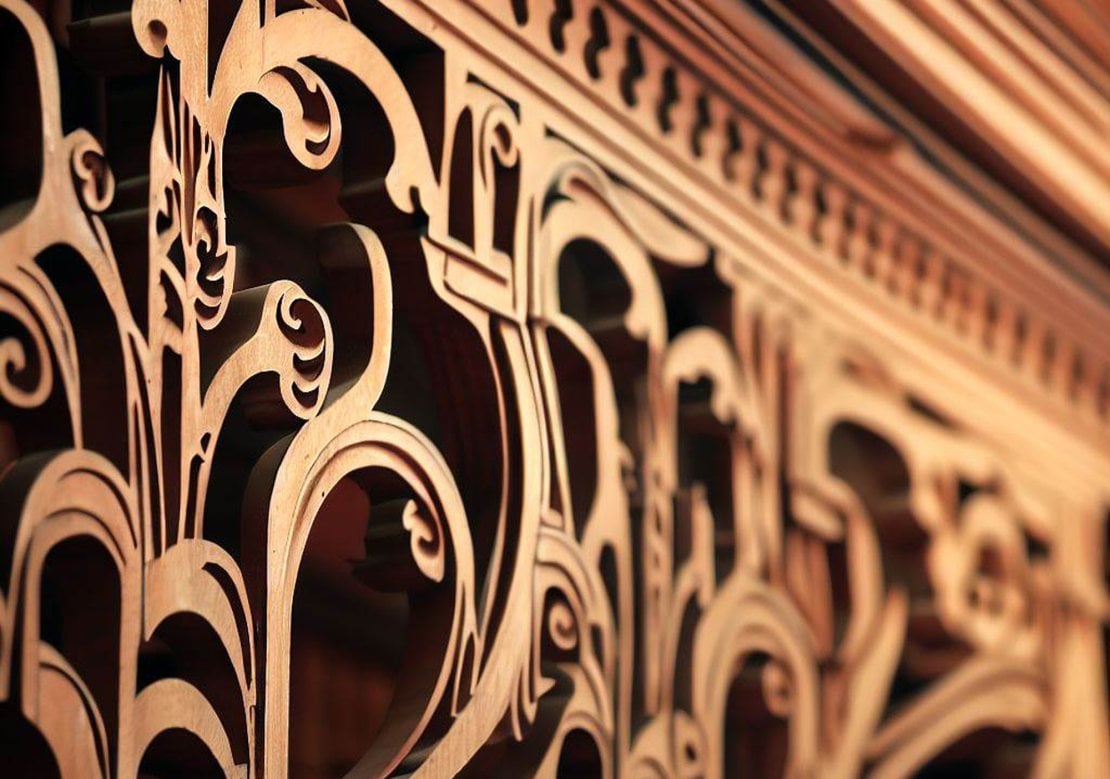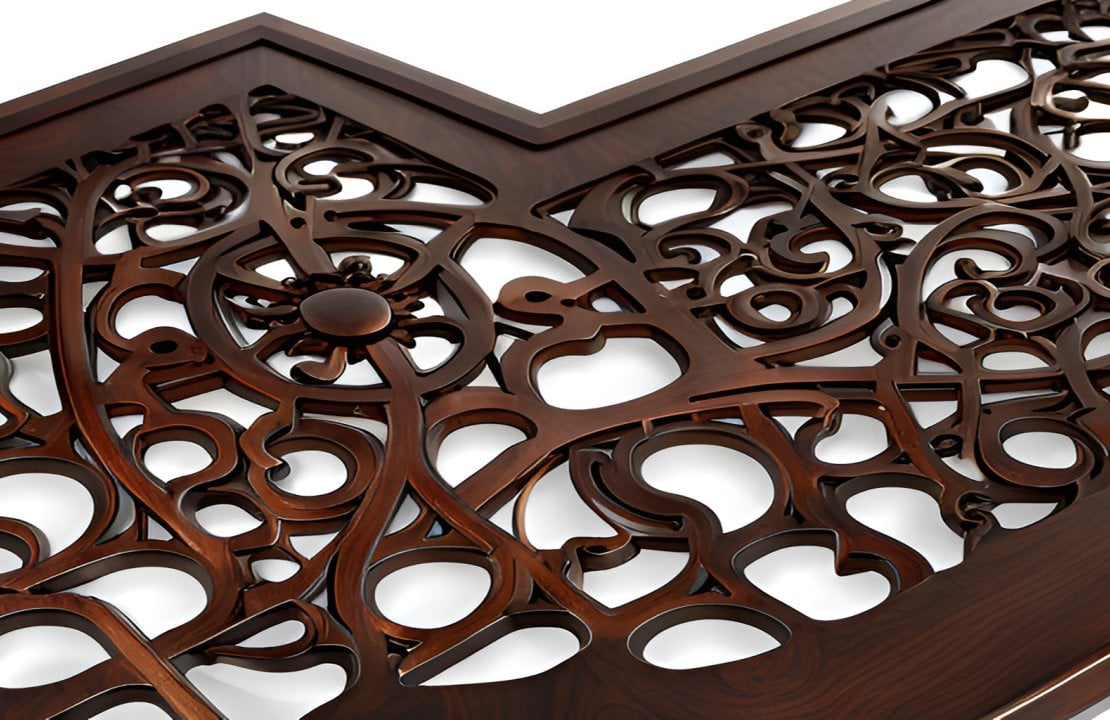Victorian Fretwork refers to the delicate patterns and designs created by interlacing or intersecting wooden strips, typically used as decorative elements in architectural features, furniture, and other interior design elements. The extensive use of Victorian fretwork adds a touch of elegance and sophistication to the overall aesthetic of Victorian furniture and Victorian interiors.
Historical Context
The word "fretwork" comes from producing it, which involves using a fretsaw to remove parts of interlaced woodwork. In fact, it dates back to the beginning of human civilisation. Researchers have uncovered fretwork on furniture in Egyptian tombs that date back some three thousand years. Egyptian furniture was the first known use of fretwork, dating back thousands of years.
The use of architectural fretwork reflected the fascination with craftsmanship, attention to detail, and the desire to showcase wealth and status during the period 1837 to 1901. It was an extremely popular decorating choice during the Victorian era when homes were covered in intricate fretwork designs. Up until the 1920s, work was done using complicated hand saws. After that, electrical motors began to replace hand saws.

Architectural Applications
Fretwork found its way into various architectural elements, both interior and exterior, during the Victorian era. Fretwork patterns can be applied to furniture and walls, used as architectural features, as window covers, radiator covers and even as screens. It can be used as a pattern on wall coverings, curtains, bedding, rugs, and tiling, among other things.
One of the most prominent applications was in the creation of decorative porch and balcony railings especially in middle class Victorian homes. Elaborate and intricate patterns were meticulously carved into wooden balusters or panels, creating a visually stunning effect. Timber fretwork was also commonly used in gables, cornices, and friezes, adding a touch of grandeur to the facades of Victorian buildings. Additionally, it was incorporated into window frames, room dividers, and staircases, enhancing the overall aesthetic appeal of the interior spaces.
Design Characteristics
Fretwork designs in Victorian style architecture were highly diverse, drawing inspiration from a wide range of sources and was an important feature in Victorian decor. Many patterns were influenced by Gothic and Moorish styles, showcasing intricate tracery and geometric motifs.
The use of arches, trefoils, quatrefoils, and interlaced circles was particularly prevalent in Victorian interiors as well as outside the house. Floral and botanical motifs, such as vines, leaves, and flowers, were also popular, reflecting the Victorian fascination with nature. Elements of Victorian Fretwork designs often combined with other wooden mouldings, resulting in complex and visually captivating compositions used in hallways, dining rooms and sitting rooms.
Materials and Techniques
Fretwork was primarily crafted from wood, such as oak, walnut, or mahogany, due to its versatility and ease of carving of these timber mouldings. The wood was carefully selected for its strength and durability, ensuring that the intricate details of the fretwork would withstand the test of time. Skilled craftsmen employed various techniques, including carving, piercing, and sawing, to create the desired patterns. In some cases, fretwork panels were also fabricated using cast iron or wrought iron, particularly in more elaborate and ornate structures.
Legacy and Preservation
The extensive use of fretwork in Victorian architecture left an indelible mark on the built environment of the era. Although many Victorian buildings have undergone renovations or demolitions over the years, efforts have been made to preserve and restore the intricate fretwork details that remain. Architectural conservation organisations and enthusiasts recognise the historical and artistic value of fretwork, striving to protect these delicate and beautiful elements for future generations to appreciate.
Famous examples of Fretwork
The great English craftsman Thomas Chippendale, who worked in the 18th century, used hand-carved fretwork in his furniture designs inspired by geometric patterns seen in ancient Chinese temples. His designs are regarded as some of the finest in the history of furniture production, and the fretwork is recognised as the defining characteristic of his work in this field.
During the Victorian period, Queen Victoria, Prince Albert and William Morris were all fans of Chippendale's work.
The works of Joe Colucci illustrate that he is so confident in the ability of "fret" or "grille" work to convey beauty and drama, whether in a stylised or realistic manner, that he makes it a point to include some kind of it in virtually all of the things he does.
The Lambton House, which served as a well-known watering hole up until the early 1960s underwent restoration recently. The most eye-catching aspect of its porch is the hand-carved bracketing, which consists of a quatrefoil design in a Gothic style that is encircled by two trefoil elements. This veneer with echoes of the ecclesiastical did an excellent job of covering up the dubious behaviour that was taking place behind it.

Before the 1850s, verandas were not common features in American homes unless they were located in the deep South. However, throughout the Victorian era, there was a tendency toward more pretty architecture and the "rocking chair porch," which is an iconic image of the United States at the end of the 19th century.
In a short amount of time, front porches were standard on all newly constructed suburban homes. Victorian Porches were later additions to houses that were built during the Colonial or Federal periods but had never had one before.
In conclusion, fretwork played a significant role in Victorian interior design, serving as a symbol of wealth, craftsmanship, and attention to detail. Its intricate patterns and delicate designs added a touch of elegance to the facades and interiors of Victorian buildings. Today, the surviving examples of fretwork stand as a testament to the artistic and architectural achievements of the Victorian era, captivating and inspiring admirers of historical design.


Posted by Joel Levinson - Aug 11, 2023 - 10:40
As an architect, interior designer, photographer, and historian, Victorian fretwork has always been of interest to me. Most recently I’ve been posting on my Facebook page photographs I took a few weeks ago of lovely Victorian homes and porches in Ocean Grove, New Jersey. I may do a book of my photographs of Victorian detailing.